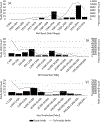Understanding oil and gas pneumatic controllers in the Denver-Julesburg basin using optical gas imaging
- PMID: 32101088
- PMCID: PMC7879391
- DOI: 10.1080/10962247.2020.1735576
Understanding oil and gas pneumatic controllers in the Denver-Julesburg basin using optical gas imaging
Abstract
In the spring of 2018, a 10-day field study was conducted in Colorado's Denver-Julesburg oil and natural gas production basin to improve information on well pad pneumatic controller (PC) populations and identify PCs with potential maintenance issues (MIs) causing excess emissions through a novel optical gas imaging (OGI) survey approach. A total of 500 natural gas-emitting PCs servicing 102 wells (4.9 PCs/well) were surveyed at 31 facilities operated by seven different companies. The PCs were characterized by their designed operational function and applications, with 83% of the PC population identified as intermittent PCs (IPCs). An OGI inspection protocol was used to investigate emissions on 447 working PCs from this set. OGI detected continuous emissions from 11.3% of observed IPCs and these were classified as experiencing some level of MIs. OGI imaging modes were observed to have a significant effect on emission detectability with high sensitivity mode detection rates being approximately 2 times higher compared to auto mode. Fourteen snapshot emission measurements (not including actuations) were conducted on IPCs in this category using a high-volume sampling device with augmented quality assurance procedures with observed emissions rates ranging from 0.1 up to 31.3 scf/hr (mean = 2.8 scf/hr). For PCs with continuous depressurization type (CPC), 36.8% had continuous emissions observed by OGI. Four supporting emission measurements were conducted on CPCs with one unit exceeding the low bleed regulatory emission threshold with an emission rate of 9.9 scf/hr (mean = 4.2 scf/hr). Additional information was collected on PC actuation events, as observed with OGI, which showed a strong correlation between observed actuation events and facility production compared to observed continuous emissions caused by MIs which did not correlate with facility production.Implications: A novel survey approach of pneumatic controllers at oil and natural gas production facilities in the Denver-Julesburg basin, using optical gas imaging and supporting emission measurements, was demonstrated as an effective method to identify controllers with potential maintenance issues causing excess emissions. The results of the pneumatic controller and optical gas imaging surveys improved information on pneumatic controller populations within the basin and also demonstrated the significant effect optical gas imaging modes have on emission detections.
Conflict of interest statement
Disclosure statement
No potential conflict of interest was reported by the authors.
Figures





Similar articles
-
Evaluating Natural Gas Emissions from Pneumatic Controllers from Upstream Oil and Gas Facilities in West Virginia.Atmos Environ X. 2023 Jan 1;17:1-10. doi: 10.1016/j.aeaoa.2022.100199. Atmos Environ X. 2023. PMID: 36643185 Free PMC article.
-
Assessment of Uinta Basin Oil and Natural Gas Well Pad Pneumatic Controller Emissions.J Environ Prot (Irvine, Calif). 2017 Apr;8(4):394-415. doi: 10.4236/jep.2017.84029. J Environ Prot (Irvine, Calif). 2017. PMID: 30319880 Free PMC article.
-
Methane emissions from process equipment at natural gas production sites in the United States: pneumatic controllers.Environ Sci Technol. 2015 Jan 6;49(1):633-40. doi: 10.1021/es5040156. Epub 2014 Dec 9. Environ Sci Technol. 2015. PMID: 25488196
-
Emissions from oil and gas operations in the United States and their air quality implications.J Air Waste Manag Assoc. 2016 Jun;66(6):549-75. doi: 10.1080/10962247.2016.1171263. J Air Waste Manag Assoc. 2016. PMID: 27249104 Review.
-
Advances in science and applications of air pollution monitoring: A case study on oil sands monitoring targeting ecosystem protection.J Air Waste Manag Assoc. 2019 Jun;69(6):661-709. doi: 10.1080/10962247.2019.1607689. J Air Waste Manag Assoc. 2019. PMID: 31082314 Review.
Cited by
-
Evaluating Natural Gas Emissions from Pneumatic Controllers from Upstream Oil and Gas Facilities in West Virginia.Atmos Environ X. 2023 Jan 1;17:1-10. doi: 10.1016/j.aeaoa.2022.100199. Atmos Environ X. 2023. PMID: 36643185 Free PMC article.
-
Detection Limits of Optical Gas Imaging for Natural Gas Leak Detection in Realistic Controlled Conditions.Environ Sci Technol. 2020 Sep 15;54(18):11506-11514. doi: 10.1021/acs.est.0c01285. Epub 2020 Aug 26. Environ Sci Technol. 2020. PMID: 32786569 Free PMC article.
-
Developing Specific Emission Factors for Natural Gas Driven Pneumatic Devices.Environ Sci Technol. 2024 Oct 22;58(42):18663-18670. doi: 10.1021/acs.est.4c05637. Epub 2024 Oct 10. Environ Sci Technol. 2024. PMID: 39434656 Free PMC article.
-
Methane emissions from oil and gas production sites and their storage tanks in West Virginia.Atmos Environ X. 2022 Dec;16:1-11. doi: 10.1016/j.aeaoa.2022.100193. Atmos Environ X. 2022. PMID: 37091901 Free PMC article.
-
Uncertainty Quantification of Methods Used to Measure Methane Emissions of 1 g CH4 h-1.Sensors (Basel). 2023 Nov 17;23(22):9246. doi: 10.3390/s23229246. Sensors (Basel). 2023. PMID: 38005631 Free PMC article.
References
-
- Allen DT, Pacsi AP, Sullivan DW, Zavala-Araiza D, Harrison M, Keen K, Fraser MP, Hill AD, Sawyer RF, and Seinfeld JH. 2014. CH4 emissions from process equipment at natural gas production sites in the United States: Pneumatic controllers. Environ. Sci. Technol. 49 (1):633–40. doi:10.1021/es5040156. - DOI - PubMed
-
- Concawe. 2017. An evaluation of an optical gas imaging system for the quantification of fugitive hydrocarbon emissions. Report no 2/15. Accessed July 23, 2019 https://www.concawe.eu/publication/an-evaluation-of-an-optical-gas-imagi....
-
- Luck B, Zimmerle D, Vaughn T, Lauderdale T, Keen K, Harrison M, Marchese AJ, Williams LL, and Allen DT. 2019. Multi-day measurements of pneumatic controller emissions reveal frequency of abnormal emissions behavior at natural gas gathering stations. Environ. Sci. Technol. Letters 6:348–52. doi:10.1021/acs.estlett.9b00158. - DOI
-
- Simpson D. 2014. Pneumatic controllers in upstream oil and gas. Oil Gas Facil. 3(5):83–96. Accessed July 24, 2019. doi:10.2118/172505-PA. - DOI
Publication types
MeSH terms
Substances
Grants and funding
LinkOut - more resources
Full Text Sources
Other Literature Sources
